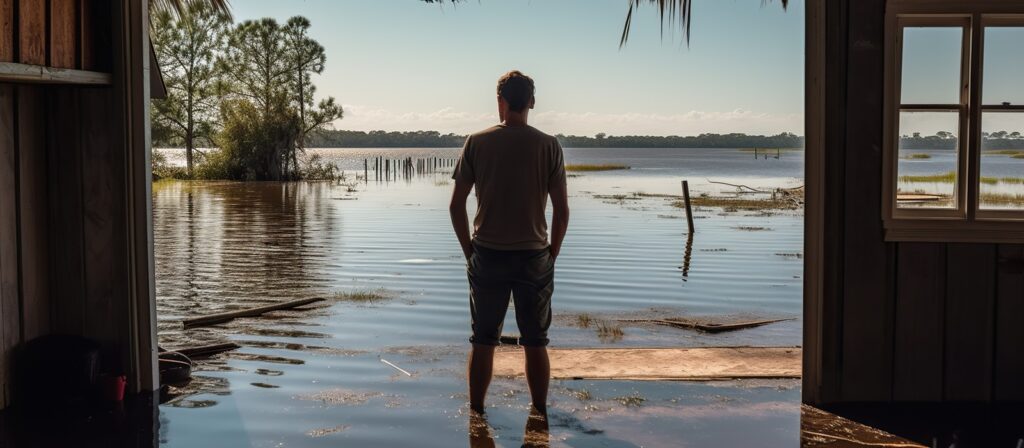In every advance or transformation of the global economy, from agriculture to the industrial revolution and international trade, insurance has played a pivotal role in enabling investment and capital flows. The transition to a net-zero emissions economy is the economic revolution of our times and insurance must once again rise to the challenge. This paper draws on expertise from within Gallagher Re and from the wider finance and climate change community to examine the scale of the risks posed by climate change itself and by the transition journey.
The climate challenge for insurance
Climate change and the international drive to shift the global economy to net-zero represent a once-in-a generation challenge to the insurance sector. We have a responsibility and an opportunity to demonstrate the value that risk management can play in protecting society against the physical risks of climate change and in supporting the investment required.
The insurance industry draws a clear distinction between physical risk and transition risk. Physical risk describes the potential damage and loss caused by climate events, while transition risk encompasses the threats to business, principally regulatory, that arise from the change to a net-zero emissions economy.
The two, however, are not entirely unconnected. Regulatory risk involves demands on industry both to build resilience to physical threats and to reduce greenhouse gas emissions. Meanwhile, the development and capital involved in building low emissions infrastructure and energy generation themselves face physical risks and uncertainties created by climate change.
But from a financial risk perspective, the threat to investment returns is far greater if we fail in the net-zero mission. Recent analysis by Singapore’s sovereign wealth fund GIC, Ortec Finance, and Cambridge Econometrics found that in a “failed transition” scenario — a world where the global temperature rises by about 4°C — nominal total investment returns could be 37% lower over the next 40 years when compared to a baseline that assumes no climate change effects.1
Even a successful transition would result in some investment costs, with returns being about 10% lower over 40 years compared to the climate-neutral baseline, according to the GIC report. But the difference is clear. In addition, in the space between complete success and complete failure lies the possibility of a disorderly transition, in which the move to net-zero is accompanied by financial turbulence and the destruction of value — and the risk of doing too little too late. This is a scenario where a delayed transition incurs economic costs but also fails to avoid significant climate change damage.
Insurance has a vital role to play in helping ensure that transition is not only achieved, but achieved with the minimum economic disruption.
Physical and transition risk
The physical risks associated with climate change are now widely recognized, from flooding to wildfires and extreme weather. Models for assessing these risks continue to develop at pace, but there is much to be done to combine the macro view of global climate change and its human and economic effects with the kind of detailed and specific risk analysis employed by insurers.
The insurance costs of natural catastrophes reached USD140 billion in 2022, up 17% on 2021’s figure of USD116B. The insured loss in dollar terms was overwhelmingly in the US. But in human terms, it was emerging markets that bore the brunt, with an estimated 50,000 lives lost due to natural catastrophes. While recognizing that the rise in nat cat losses is primarily driven by increased insured loss values in regions hit by the events, there is a growing recognition that climate change is a systemic risk that will ultimately be accretive to that trend.
Assessing, managing, and insuring transition risk requires a fundamental reappraisal by some elements of the insurance industry. The transition is a complex web of public and private investment, financial incentives, and policy measures, involving short- and long-term views of risk — and effective political and business governance.
Individual businesses and entire sectors will need to be restructured to meet regulatory demands. For some, this restructuring will be transformational. For others, it will mean obsolescence.
Providing insurance solutions to the new industries of renewable energy is an enormous element in the transition. But helping businesses transform, or even manage decline, is no less vital if that transition is to happen without unnecessary economic damage and dislocation.
The drivers of risk and opportunity
The pressure on industry to transition comes from a wide range of stakeholders, from governments and nongovernmental organizations (NGOs) to campaign groups and public opinion. The insurance and reinsurance industry will also be a key link in the chain, whose job is to assess and price risk and help the insured adapt.
For businesses and investors, there are risks to existing entities that need to be managed and mitigated. There are also opportunities in the net-zero economy.
As Antoine Bavandi, Global Head of Public Sector, Parametric & Climate Resilience Solutions at Gallagher Re, puts it, “There will be a direct short-term impact on some activities. But you can see those changes coming, and you can anticipate them. Businesses should work with regulators to transition out of these activities and grasp the arising new opportunities.”
Those opportunities are once-in-a-generation, and vast. In 2020, a report by the Global Financial Markets Association and Boston Consulting Group (BCG) estimated that the full capital investment required for the transition will amount to between USD100 trillion and USD150 trillion by 2050.2 Bloomberg estimated last year that the total required was at the upper end of that bracket.3
Countless legacy assets will need to be run down, replaced, or retrofitted to meet targets. Companies’ business models and entire sectors will need to adapt and transition, either reducing the carbon footprint of existing operations or exiting those activities altogether and investing in new activities.
Old assets will continue to need insurance and may need additional cover to address new challenges, from physical risk to regulatory exposure. New assets, from renewable energy projects to real estate and infrastructure, will naturally need insurance to provide the confidence for capital to flow effectively into them.
Many of these risks are new and there is a lack of historical data and reliable models to support pricing. As a result, there is a real danger that gaps will emerge in insurance provision, and without insurance, capital investment is hampered. The insurance industry will need to close these gaps.
Fulfilling its role in the transition is also an enormous opportunity for the insurance industry. In the UK alone, BCG estimates that by 2050, green assets will account for about 66% of the property and casualty market (up from just 1% in 2020) and could represent GBP30 billion (USD37.2 billion) in premiums.4 Net-zero is not only a positive for the planet, but also for insurers’ balance sheets.
The vast bulk of this investment — and the insurance support that it will need — will come from private capital. But to be an effective part of a global solution it will also require a deep partnership with public finance and state planning.

This article is reproduced with the kind permission of ICMIF Supporting Member Gallagher Re. For more information click here.
Published March 2024
A changing climate in regulation
The UK’s Prudential Regulation Authority (PRA), part of the Bank of England, has been undertaking work to address the challenges to financial services from climate change, including the possibility of adjusting capital requirements on banks and insurers to take account of climate risk.5
The PRA has noted the twin risks to capital faced by the insurance industry, firstly from potential losses due to climate-related claims and secondly from the losses that may occur in investment portfolios. However, the overwhelming message from the PRA is that more work needs to be done to understand the risks on all fronts and what they may mean for regulation, most significantly for insurers’ capital requirements. Any change in capital requirements will have implications not only for the insurance industry, but also for the insured. The debate among insurance regulators echoes the potential for regulatory risk across other industries.
Transition across the insurance value chain
Rising to the challenge of the global transition will require adaptations and development across the insurance value chain and will include greater interaction, cooperation and sharing of insights. There is no element of the insurance value chain that will not be part of the solution and the cover required will be the full range of products, from business interruption to construction and property to casualty.
In addition:
- Brokers will need to develop data and analytics capabilities to provide the insight and advisory services that clients will need to navigate both changing physical risks, and the transition to the net-zero economy. Climate change and the transition must be addressed as part of their financial risk management process.
- For insurers, product innovation will be essential to address the uncertainties of newly emerging risks including in developing countries, and bridge the potential gaps in cover in a way that is viable and profitable for the insurance industry.
- And for reinsurers, the scale of the investment required, to shift business and industry toward a low emissions economy, will necessitate a significant allocation of capital. However, top-down assessments will need to be refined, as large-scale aggregate views of risk may not be suitable.
One theme that crosses all parts of the value chain is the need for a long-term view. Traditionally, insurance has assessed risk and return across relatively short time periods. However, with most governments setting a 2050 deadline for net-zero and climate change itself an open-ended risk, a long-term approach will be essential if the industry is to properly align itself with clients, regulators, and investors.
Key themes for the insurance industry
Advisory capability
Advisory capacity will be the biggest single advance required; this is a field in which brokers such as Gallagher Re have a vital role to play, bringing together data and analytics capabilities with climate science and financial risk modeling.
Expanding advisory capacity will require new skills and contributions from fields of expertise that have not traditionally been part of the insurance toolkit. Gallagher Re’s appointment of Steve Bowen as Chief Science Officer and Antoine Bavandi in the role of managing public-private partnerships are just two examples of the kind of wider engagement and expertise that our industry will increasingly require.
For carriers too, it is essential that these skills and expertise are fully integrated into their core functions, as well as within financial risk management. Only then will insurance practitioners be able to provide the depth and sophistication of advisory services that clients will increasingly require.
Data and analytics
Climate risk models are still in their infancy and a gap exists between climate science and the peril models used in insurance. The value of historical data sets is being eroded as patterns of physical risk change and the distinction between primary and secondary perils is also becoming less meaningful.
Primary perils have typically been regarded as those involving catastrophic events and significant losses that are well monitored, such as earthquakes and hurricanes. Insurance loss figures, however, increasingly suggest that events typically regarded as secondary are creating greater losses.
Bowen identifies severe convection storms — thunderstorms — as being one of the two leading causes of catastrophe losses in the US market. “Severe convection storm losses have become increasingly expensive for the insurance industry and just in the past decade alone, they have annually averaged USD25B. 2023 has already set a new US annual record with insured SCS loss costs exceeding USD50B. While tropical cyclones can be significantly more expensive on a per-event basis, the much higher frequency of SCS events can lead to higher annual aggregated costs,” he notes.
“Since 1990, the SCS peril in the US has accounted for 144 individual billion-dollar insured events. All other perils combined for just 85 such events. Stats like this help drive the notion that ‘secondary’ perils can very much look ‘primary’ in their scale.”
At the same time, the types of economic loss that can be caused by climate-related events often fall between the gaps of insurance programs. Flooding may cause limited short-term physical damage but can lead to significant business interruptions and a long tail of knock-on events through supply chains and into other sectors. (See our companion paper, “The Weakest Link: Climate Change Threats to Supply Chains.”)
The need for data and analysis that can address the novelty and interconnectedness of risk will be essential in bridging gaps in insurance provision.
A research paper prepared for the UN-backed Global Center on Adaptation in 20196 highlighted the low penetration of insurance in emerging markets — often lower than 1%. Poor recognition of the role that insurance can play was identified as part of the problem. But the availability of suitable risk models was another factor, which in turn constrains the flow of capital and leads to “insufficient reinsurance capacity.”
The scale of the challenge in developing appropriate models, even at a global level, should not be underestimated. A commonly used analysis comes from the Network for Greening the Financial System (NFGS) — a network of central banks and regulators — which in 2020, produced a potential modeling framework to monitor climate change effects. But some have argued that, while this may be a useful starting point, many organizations go no further.
A recent report by the UK’s Institute and Faculty of Actuaries (IoFA) and the University of Exeter delivered a stark verdict on the state of climate modeling being employed in financial services entitled, “The Emperor’s New Climate Scenarios.”7
Its headline finding is that “climate-scenario models in financial services are significantly underestimating climate risk.” The report further warns that relying solely on scenarios such as the NFGS could lead to “group think” and complacency.
Gallagher Re is working on its own analysis of the problem and Yingzhen Chuang, Global Head of Sustainability Risk, shares some of the concerns raised by the IoFA. She notes, “We should be trying to diversify this analysis, be aware of the limitations in NFGS, and not just adopt it blindly.”
Product provision
Product innovation will be key to bridging the gaps in insurance programs. These gaps may emerge because risk models are still developing, because regulation is changing, or because some aspects of the transition are inherently uncertain.
Parametric cover is developing as a potentially highly useful tool with addressing many of these new and uncertain risks. Parametric products are based not on the actual loss incurred by an event, but use the event itself — for example, a certain temperature or rainfall level being exceeded — to trigger a pre-agreed payout. Such policies can provide payment more swiftly than cover that requires an assessment of loss.
The precise forms of parametric cover can vary. Some implementations can be structured as an insurance contract, while others can look more like a derivative instrument. The financial risk management involved can therefore vary across jurisdictions.
To date, parametric insurance has primarily been focused on physical risk — the classic example being cover for agricultural activity facing unusual or extreme weather. But Chuang argues that parametric insurance could also play a valuable role in transition risk. Renewable energy, for example, faces significant uncertainties since electricity generation from wind, solar, or other renewable technologies is to some degree unpredictable.
Chuang explains, “Traditional models calculate the probability of the loss based on historic data, whereas parametrics are calculating the probability of an index event, such as rain or heat, happening. This is theoretically easier to model because you don’t have to go through all the event simulations. So parametrics is used in areas where there’s difficulty getting traditional insurance because the data is not particularly good and so the price is too high.
Parametric cover could be useful for transition risk. We have held discussions with a client whose business was generating hydropower electricity to sell to the grid. We suggested a parametric product that would correlate rainfall to the water levels needed to generate electricity. But instead of basing a product on a specific loss, which could have been difficult to model, the parametric would pay out based on predetermined rainfall levels.”
Transition risk is often seen as long-term, but as this example illustrates, there can also be a short-term dimension. Investment in renewables involves precisely this type of short-term risk, for which parametric insurance might be able to provide at least partial cover.
Incentivization
Retail insurance products, notably health and automotive lines, have embraced a dynamic relationship with clients, incentivizing behavior that reduces risk in return for reduced premiums. Climate change and transition risk are fertile grounds for this approach.
The regulatory aspect of transition risk is an obvious opportunity for insurers to help provide incentives for clients to anticipate and adapt to regulation that will force transformation or render some industry sectors unviable.
Insurers and reinsurers with extensive exposure to such sectors, for example, fossil fuel extraction, will need to diversify and/or help their existing clients to do so. So far, there has been no great rush to exit among reinsurers and existing projects and clients should expect to continue to receive cover.
However, increasingly, that cover should be expected to come with conditions or incentives. The insurance sector, including underwriters, faces the same pressures as other industries to reduce its carbon footprint and the definition of Scope 3 emissions includes supply chains and emissions downstream of an insured business (see Gallagher Re’s companion paper, “Decarbonizing Underwriting Portfolios.”)
Public-private partnerships
The transition to a net-zero economy and building resilience to climate change are being driven to a great extent by governmental initiatives and regulations. The insurance sector will need to strengthen its skills in developing relationships and partnerships with the public sector in developed countries and emerging economies. It will also require governments to engage with and support the insurance sector.
In some cases, the government will need to provide support for private sector insurance through subsidies to bridge the gaps that might emerge in commercial coverage. For example, the Flood Re partnership between the UK government and insurers was created to address flood risk to property for which a purely private market might lack appetite.
The government can provide subsidies and guarantees that will allow private insurance to engage and provide the bulk of cover, thus helping to deliver the scale of capital required both to strengthen resilience and aid transition.
Partnerships between insurers and governments will be vital for tackling climate losses and transition risk. Coherent strategies that cut across resilience and adaptation dimensions, ex-post and ex-ante risk financing (financing that uses both historic returns to predict future risks associated with an investment as well as providing capital for investments that consider returns that are earned before the risk actually takes place), will be essential in addressing the protection gap at scale, helping reduce insurance costs whilst providing investors with confidence to engage.
Bavandi says, “National plans need to nurture a public-private ecosystem where there’s alignment of interests between public and private stakeholders, a win-win between partners involved for the scheme to be sustainable. In insurance terms, this means achieving the right level of government subsidies with profitable enough premiums so you can rely on support from those insurance markets in five or ten years’ time.”
Partnerships between the public and private sectors are also an area where incentivization can be highly effective in the form of blended finance, where the provision of capital can be bundled with insurance.
One example of this is ‘resilience bonds’ that combine finance for climate-resilient public infrastructure linked to discounted insurance or insurance rebates as resilience targets are met. A well-known example of their use is the City of Miami’s USD400M Forever Bond, approved in 2017.
At the time, hopes were high that resilience bonds could be a cornerstone of building climate resilience, but the idea has proved harder to roll out more widely. The core challenge has been the insurance industry’s traditional timescales.
“Only a few insurers or reinsurers will commit to offering very long-term policies of 20 or 30 years, which is what these typically need to be,” explains Bavandi. “So, implementing these in practice is challenging. Too often, our industry does not see their immediate value, because there are no short-term benefits. This time dimension is key, because if want to move things at scale, we need to look at risk and returns that go beyond the next two or three years.”
Carbon offsetting
Carbon offsetting and the carbon credit market are now well-established aspects of the transition. The global market for voluntary carbon offsets was valued at roughly USD2 billion in 2021, and is set to grow to between USD10 billion and USD40 billion by 2030, according to a recent report jointly authored by energy giant Shell and the BCG.8
Paying for trees that sequester carbon from the atmosphere or other carbon-reduction projects creates carbon credits, which companies can offset against their own emissions and so help balance their carbon account to net-zero.
However, the market is not without its challenges. Firstly, the market has faced frequent criticism for either failing to create the levels of carbon capture claimed or even for entirely bogus offset projects. Secondly, valuing carbon credits for financial accounting purposes is far from straightforward. Finally, the real assets behind carbon offsets (typically trees) themselves face physical risks — the loss of carbon-offset forest in this year’s Canadian wildfires being the most recent headline-making example.
Ed Messer, Head of Analytics, UK at Gallagher Re, says these significant and rapidly growing assets are often underinsured, “Insurance penetration is very low, but we think that they will increase dramatically over the next couple of years as the market grows and the value of capital invested in carbon offsets expands.”
The physical risk to carbon offset projects is the most obvious and easiest for insurance to address and, of course, circles directly back to the physical risk modeling that is a perpetual theme in this paper.
The risk of fraud can also be overcome. “There’s been a huge amount of press recently about some of the underlying projects themselves being fraudulent. A farmer in South America could claim to be creating forests, but it could be completely fraudulent — either because the forest does not exist at all or because it is of poor quality and will not sequester as much carbon from the atmosphere as it claims. That can also be protected through insurance,” says Messer.
The intangible nature of carbon credit certificates and their storage at one of two electronic registries — Verra and Gold Standard — also pose cyber risks of theft or damage. These are risks that, again, are amenable to insurance protection and cyber is one of the areas in which Gallagher Re is highly active.
Finally, the financial accounting complexity can be simplified once an insurance policy is in place, as Messer explains, “If you’re a big company and you’re using carbon offsets, they are intangible assets on your balance sheet. But if you can buy a policy that protects you from the downside risk of those credits disappearing, you can start accounting for them in a tangible way on the balance sheet.”
As the carbon offset market expands dramatically over the coming years, it is insurance that will help integrate this aspect of the global transition into the mainstream of financial risk management. For more on this subject, see Gallagher Re’s blog post, “Building Confidence in Carbon Credits.”
Insurance checklist
The insurance sector will be a pivotal player in the transition to net-zero. Adapting and building resilience to climate change; helping existing industries change their business models and navigate regulatory risk and insuring the new and growing sectors of renewable energy will all require the mobilization of vast amounts of capital. Insurance in a wide range of forms can provide confidence and stability to these endeavors, stimulating capital flows and providing greater confidence in investment, both public and private.
The transition will involve radical changes for the insurance sector itself, as it strives to meet changing regulations, and adapt to much longer-term risk and return models. But it will also mean an expansion of insurance balance sheets and the opportunity for business growth and innovation.
Companies across the sector need to consider key steps to adapt to a world in transition that will enable them to meet this capital requirement and secure their own success. This may include:
- Recruiting and nurturing expertise to develop risk analysis and solutions. This will involve stepping outside the traditional insurance comfort zone by working with experts in climate, macroeconomics and with public sector partners.
- Building greater advisory capacity to help clients. Emerging and changing risks — physical, regulatory, and financial — mean the insured will need advisory services that are even more tailored to individual client challenges.
- Helping clients develop resilience and adaptation strategies. To be effective, insurance will need to provide more than just cover; it will also need to engage with clients’ business strategies, advising and incentivizing investments and actions that will help businesses reduce the risk of transition and maximize the opportunities.
- Improving communication. Data analysis, product innovation, and engagement with regulatory change are industry-wide issues and require industry-wide responses from brokers, insurers, reinsurers, and the insured.
The drive to a low emissions economy is now a firm objective of governments and intergovernmental bodies that are driving regulation, backed by pressure from the public and NGOs. The precise path of climate change is unknown and sometimes disputed, but the economic transformation now underway is unstoppable. The insurance industry must adapt and prove once again its vital role in helping to build security and prosperity.
1 Integrating Climate Scenario Analysis into Investment Management: A 2023 Update, GIC and Ortec Finance, April 2023.
2 Climate Finance Markets and the Real Economy, Global Financial Markets Association, December 2020.
3 The $7 Trillion a Year Needed to Hit Net-Zero Goal, Bloomberg New Energy Finance, December 2022.
4 The Net-Zero Insurer, BCG, July 2022.
5 Bank of England report on climate-related risks and the regulatory capital frameworks, Bank of England, March 2023.
6 Insurance for Climate Adaptation, Global Center on Adaptation, July 2019.
7 The Emperor’s New Climate Scenarios, Institute and Faculty of Actuaries, July 2023.
8 The voluntary carbon market: 2022 insights and trends, Shell/BCG, 2023.





